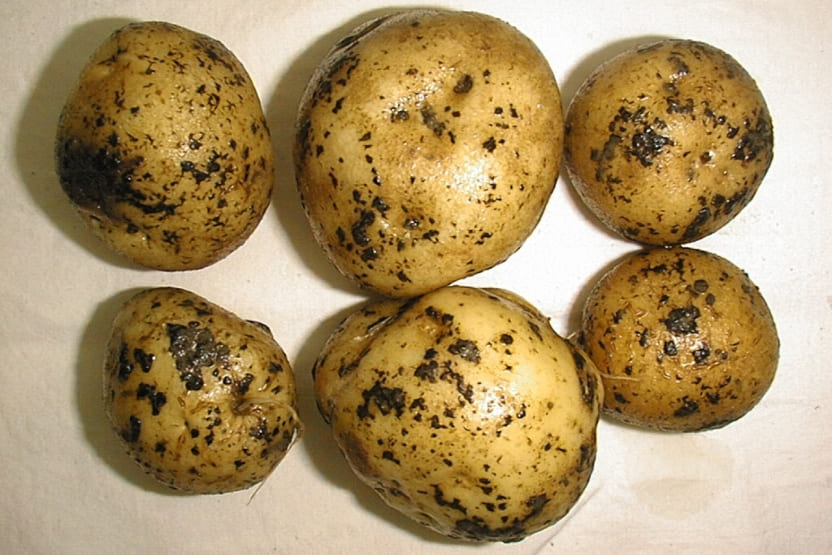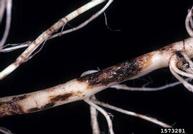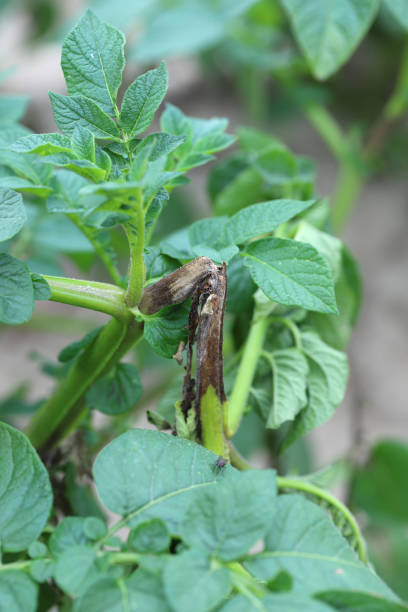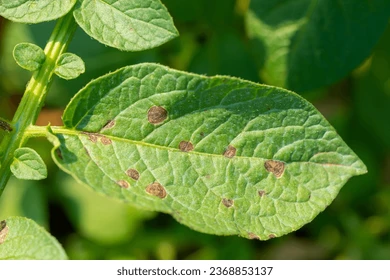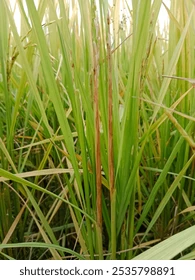Black Scurf of potato:
- Disease Name: Black Scurf of Potato
- Causal Organism:
- Affecting Stage:
- Affects the crop during the sprouting, vegetative, and tuberization stages.
- Primarily seen on tubers at harvest and during storage.
Stem and Leaf Symptoms:
- Poor emergence or irregular growth of plants due to damage to emerging sprouts.
- Dark brown lesions or cankers on the stem near the soil line, causing plant stunting.
- Severe infections may cause wilting, yellowing of lower leaves, and plant death.
Tuber Symptoms:
- Presence of black, hard, crust-like structures (sclerotia) on the tuber surface, giving it a rough appearance.
- Tuber infections may not penetrate deeply but can affect the marketability.
- In storage, infected tubers may develop dry rot or shriveling over time.
- Favourable Conditions:
- Cool and moist soil conditions during sprouting and tuber formation.
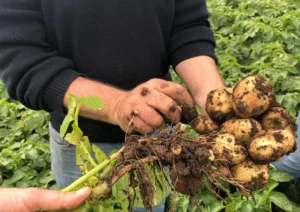
- Poor soil drainage or waterlogging.
- Use of disease infected seed tubers or planting in infested fields.
- Dense planting and poor crop rotation practices.
- Cultural Control:
- Use certified, disease-free seed potatoes to prevent initial infections.
- Rotate crops with nonhost crops like cereals or legumes to break the disease cycle.
- Avoid planting in fields with a history of Rhizoctonia infection for 2-3 years.
- Practice proper soil drainage and avoid overwatering during the crop cycle.
- Ensure early planting in warmer soils to reduce disease severity.
- Harvest tubers at the right maturity to minimize sclerotia formation.
- Organic Controls:
- Treat seed tubers with Trichoderma viride or Pseudomonas fluorescens to suppress the pathogen.
- Apply well decomposed organic manure or compost to improve soil health.
- Use neem cake or other biofertilizers as a soil amendment to reduce fungal inoculum.
- Chemical Control:
- Treat seed tubers with Carbendazim 50% WP @ 2-3g/kg seed before planting.
- Use Fluopyram 17.7% + Tebuconazole 17.7% SC @ 1 ml/liter of water as a foliar spray to manage soilborne infections.
- Azoxystrobin 23% SC @ 1 ml/liter of water as a soil drench to reduce fungal inoculum.
- Validamycin 3% L @ 2 ml/liter of water for preventive soil treatment.
- Trade Names of Chemicals:
- Bavistin (Carbendazim 50% WP) – BASF.
- Luna Experience (Fluopyram 17.7% + Tebuconazole 17.7% SC) – Bayer.
- Amistar (Azoxystrobin 23% SC) – Syngenta.
- Validacin (Validamycin 3% L) – Tata Rallis.
By implementing these management practices, Black Scurf of potato can be effectively controlled, improving crop health, yield, and marketability of tubers.
Black Scurf of potato:
- Disease Name: Black Scurf of Potato
- Causal Organism:
Rhizoctonia solani (fungus)
- Affecting Stage:
- Affects the crop during the sprouting, vegetative, and tuberization stages.
- Primarily seen on tubers at harvest and during storage.
- Symptoms:
Stem and Leaf Symptoms:
- Poor emergence or irregular growth of plants due to damage to emerging sprouts.
- Dark brown lesions or cankers on the stem near the soil line, causing plant stunting.
- Severe infections may cause wilting, yellowing of lower leaves, and plant death.
Tuber Symptoms:
- Presence of black, hard, crust-like structures (sclerotia) on the tuber surface, giving it a rough appearance.
- Tuber infections may not penetrate deeply but can affect the marketability.
- In storage, infected tubers may develop dry rot or shriveling over time.
- Favourable Conditions:
- Cool and moist soil conditions during sprouting and tuber formation.
- Poor soil drainage or waterlogging.
- Use of disease infected seed tubers or planting in infested fields.
- Dense planting and poor crop rotation practices.
- Cultural Control:
- Use certified, disease-free seed potatoes to prevent initial infections.
- Rotate crops with nonhost crops like cereals or legumes to break the disease cycle.
- Avoid planting in fields with a history of Rhizoctonia infection for 2-3 years.
- Practice proper soil drainage and avoid overwatering during the crop cycle.
- Ensure early planting in warmer soils to reduce disease severity.
- Harvest tubers at the right maturity to minimize sclerotia formation.
- Organic Controls:
- Treat seed tubers with Trichoderma viride or Pseudomonas fluorescens to suppress the pathogen.
- Apply well decomposed organic manure or compost to improve soil health.
- Use neem cake or other biofertilizers as a soil amendment to reduce fungal inoculum.
- Chemical Control:
- Treat seed tubers with Carbendazim 50% WP @ 2-3g/kg seed before planting.
- Use Fluopyram 17.7% + Tebuconazole 17.7% SC @ 1 ml/liter of water as a foliar spray to manage soilborne infections.
- Azoxystrobin 23% SC @ 1 ml/liter of water as a soil drench to reduce fungal inoculum.
- Validamycin 3% L @ 2 ml/liter of water for preventive soil treatment.
- Trade Names of Chemicals:
- Bavistin (Carbendazim 50% WP) – BASF.
- Luna Experience (Fluopyram 17.7% + Tebuconazole 17.7% SC) – Bayer.
- Amistar (Azoxystrobin 23% SC) – Syngenta.
- Validacin (Validamycin 3% L) – Tata Rallis.
By implementing these management practices, Black Scurf of potato can be effectively controlled, improving crop health, yield, and marketability of tubers.
